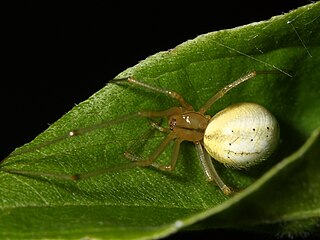
Theridiidae, also known as the tangle-web spiders, cobweb spiders and comb-footed spiders, is a large family of araneomorph spiders first described by Carl Jakob Sundevall in 1833. This diverse, globally distributed family includes over 3,000 species in 124 genera, and is the most common arthropod found in human dwellings throughout the world.

Oonopidae, also known as goblin spiders, is a family of spiders consisting of over 1,600 described species in about 113 genera worldwide, with total species diversity estimated at 2000 to 2500 species. The type genus of the family is OonopsKeyserling, 1835.

Linyphiidae, spiders commonly known as sheet weavers, or money spiders is a family of very small spiders comprising 4706 described species in 620 genera worldwide. This makes Linyphiidae the second largest family of spiders after the Salticidae. The family is poorly understood due to their small body size and wide distribution; new genera and species are still being discovered throughout the world. The newest such genus is Himalafurca from Nepal, formally described in April 2021 by Tanasevitch. Since it is so difficult to identify such tiny spiders, there are regular changes in taxonomy as species are combined or divided.

Scaffold web spiders or cave cobweb spiders (Nesticidae) are a family of araneomorph spiders closely allied with tangle-web spiders (Theridiidae). Like the Theridiidae, these spiders have a comb of serrated bristles on the hind tarsi that are used to pull silk bands from the spinnerets. Nesticidae contains 16 genera and about 300 species, many of which are associated with caves or overhangs. The genus Nesticus is the type for the family and is found throughout the world. The related Eidmannella has speciated considerably in Texas caves and includes some extremely localized species that are considered threatened. One species, Eidmannella pallida, is found in caves and under overhangs, but also in agricultural fields and other habitats away from such restricted areas. The genus Carpathonesticus is found in central Eurasia.

Ochyroceratidae is a six-eyed spider family, with 165 described species in ten genera. They are common inhabitants of caves and the tropical forest litter of South Africa, the Caribbean, Asia and South America. Considered an ecological counterpart of the Linyphiidae of the northern temperate zone, species are especially diverse in the Indo-Pacific region.
Seychellia is a genus of long-legged cave spiders that was first described by Michael I. Saaristo in 1978.
Midia is a monotypic genus of dwarf spiders containing the single species, Midia midas. It was first described by Michael I. Saaristo & J. Wunderlich in 1995.
Cousinea is a genus of spiders in the family Oonopidae. It was first described in 2001 by Saaristo. As of 2017, it contains only one species, Cousinea keeleyi, found in the Seychelles.
Lionneta is a genus of spiders in the family Oonopidae. It was first described in 1979 by Benoit. As of 2017, it contains 8 species, all of them from the Seychelles.
Cenemus is a genus of Seychelloise cellar spiders that was first described by Michael I. Saaristo in 2001. As of June 2019 it contains only three species, found only on the Seychelles: C. culiculus, C. mikehilli, and C. silhouette.
Ascetophantes is a monotypic genus of Asian dwarf spiders containing the single species, Ascetophantes asceticus. It was first described by A. V. Tanasevitch & Michael I. Saaristo in 2006, and has only been found in Nepal.
Cornicephalus is a monotypic genus of East Asian dwarf spiders containing the single species, Cornicephalus jilinensis. It was first described by Michael I. Saaristo & J. Wunderlich in 1995, and has only been found in China.
Formiphantes is a monotypic genus of dwarf spiders containing the single species, Formiphantes lephthyphantiformis. It was first described by Michael I. Saaristo & A. V. Tanasevitch in 1996.
Indophantes is a genus of Asian dwarf spiders that was first described by Michael I. Saaristo & A. V. Tanasevitch in 2003.
Sesato is a monotypic genus of African comb-footed spiders containing the single species, Sesato setosa. It was first described by Michael I. Saaristo in 2006, and is found on the Seychelles.

Seycellesa is a genus of spiders in the family Theridiidae. It consists of only its type species: Seycellesa braueri, which is endangered and endemic to the Seychelles.
Michael I. Saaristo was a Finnish arachnologist, with a particular interest in the spiders of the Seychelles. The World Spider Catalog lists 61 genus names or synonyms and 109 species names or synonyms of which he is the sole or co-author.
Euso muehlenbergi is a species of spiders in the family Ochyroceratidae. It was first described in 1998 by Michael Saaristo. As of 2021, it is the only species in the genus Euso, erected by Michael Saaristo in 2001. It is found in the Seychelles.
Prida sechellensis is a species of spiders in the family Oonopidae. It was first described by Benoit in 1979, and was moved to its present genus in 2001 by Saaristo. As of 2017, it is the sole species in the genus Prida. It is found in the Seychelles.
Bardala labarda is the only species in the monotypic genus Bardala, a member of the comb-footed spider family Theridiidae. It was first described by Michael I. Saaristo in 2006, and is endemic to the coral atoll of Aldabra.





